Water, water, everywhere…
Camping in the backwoods or traveling through Mexico means you’ll need clean drinking water all day, every day. Even if you’re surrounded by enough civilization that bottled water is readily and cheaply available, it doesn’t hurt to have a portable water filter or purifier for those days when all the stores are closed, or you’re too lazy to go outside, or you see someone filling up empty water bottles from the tap to be resold in stores again. Ew.
Luckily for all of us, portable water filters have actually gotten pretty great recently. And no, I’m not talking about the well-known options that have great marketing and cost hundreds of dollars and don’t filter out viruses dammit. Why do they cost so much if they still let bugs through that’ll kill me!? Argh!
The options I’m talking about are comprehensive filtration devices, with technology so good that they’ll handle even the tiniest of microscopic organisms, which most traditional backpacking filters can’t handle. You can fill up from a stagnant pond in sub-Saharan Africa and you’ll be just fine. And isn’t that lovely?
What kind of water filter or purifier do I need?

This is where it starts getting technical, but the way I look at it, there are three major categories of contaminants worth discussing:
- Chemical: Lead, arsenic, chlorine, and iodine come to mind. These are more often found in tap water than river water, so if you’re traveling abroad (or filtering at home), you’d want something that can help with these. Dirt and dust are important to remove as well, but pretty much every filter on the market will do that. I’m not aware of anything that’ll filter out all chemicals, but carbon filtration is the most common method for handling these, and is quite helpful.
- Bacterial (and bacterially-sized things): These are the most common biological contaminants, and the most important things to filter, whether you’re traveling to another country, or hiking in your own. There are other microorganisms out there that can cause illnesses (such as protozoan cysts, like giardia and cryptosporidium), but they’re similarly sized, so if a filter can handle bacteria, they can handle the other ones too.
- Viral: Viruses, the smallest organisms on earth, bypass most filters. Viruses are pretty rare, and generally only found in rural environments in developing countries. You probably don’t need viral filtration if you’re hiking through North America or Western Europe (which is part of the reason why filters that remove viruses are so rare), but…well, if it can do it, great.
Ideally, you’d want something that can handle all three, and that’s what this list is about. To the best of my knowledge, these are the best portable water purifiers on the market today. Significantly cheaper options exist, they won’t work nearly as well as these.
This list is split into two parts, starting with…
Part 1: If you need total filtration (including viruses)
The following devices offer all-in-one filtration, including large dirt particles, harmful chemicals, bacteria and bacterially-sized microorganisms (like cysts and giardia), and viruses. If you’re going to remote areas in developing countries, viral filtration is important; if you’re hiking around North America or filtering tap water in Western Europe, you probably don’t.
There are certain things they won’t remove (salt, for example), but the options listed here offer the most comprehensive filtration on the market, and you probably won’t find something that does. These will remove all harmful biological contaminants, and certain chemicals, making tap water or river water taste great, and safe to drink.
1) Lifesaver Bottle: $150
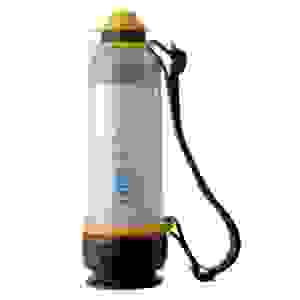
Update: It looks like the Lifesaver will be discontinued. I’m not entirely sure if this is temporary, but I’ll keep this updated if things change.
The Lifesaver Bottle was designed for the developing world, featuring an all-in-one portable water purifier that could provide clean drinking water for the 3 billion people that need it at a total investment of $20 billion. Makes you want to donate, doesn’t it?
As its design goals were simplicity and cost-effectiveness, it happens to suit the needs of backpackers and hikers just as well, and is readily available for purchase by first-world consumers, who are encouraged to participate in a buy-one, donate-one program.
The bottle has a filtration and pump system housed entirely within the bottle, so you pump a few times to press the water through the super-fine filter, and then you can drink. The bottle has a watertight cap, a carrying strap, has completely replaceable parts, and can even handle viruses.
For a while the Lifesaver was far and away the most cost-effective option on the market, though a couple new options have emerged that are lighter, don’t require pumping, and don’t need to be submerged upside down in a river to fill it up, like the Lifesaver does; but it’s still quite good.
The following numbers are estimates for the $150 Lifesaver Bottle 4000, with a limit of 4000 liters, and assume high-frequency replacement of carbon filters, available in $30 packs of 4 which treat 250 liters each. The 6000 liter version and carbon filter value packs can reduce the long-term costs listed below by about half.
- Unit price: $150 (4000 liter version)
- Replacement parts: $100 per cartridge, $8 per carbon filter, $6 per pre-filter
- Lifespan: 4000 liters (carbon filters need more frequent replacement)
- Initial water treatment cost: $0.06 per liter
- Recurring water treatment cost (replacement cartridges + filters): $0.05 per liter
- Empty weight: 22 ounces (623 grams)
Buy it here.
2) The Grayl Ultralight: $60
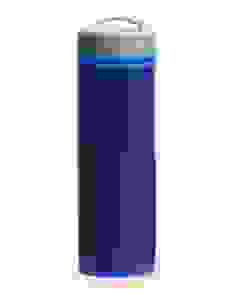
Frequently referred to as the Holy Grail of water purifiers (doesn’t everyone love puns?) the Grayl was designed by someone who got tired of drinking from sporty bottles with gigantic logos and flashy colors. This one offers the same great filtration performance as anything else you’ll find, but without the need for pumping, sucking, squeezing, or waiting.
The filter mechanism works like a French press; you fill up the lower chamber, and press the upper unit down into it. It takes about 15 seconds, after which you can drink just like you would from a regular bottle, without having to suck up the water through a straw. It also means you can pour out purified water into a cup for a friend, or fill up spare bottles for a long trip, and you’ll be hauling clean water around with you, instead of dirty water.
The Grayl has multiple filter unit options which can be swapped out according to your needs, including a low-cost tap water filter, or the top-of-the-line Purifier cartridge, which can handle viruses (removing 99.9999% of them), and 99.9999% of bacteria, along with other microorganisms and chemicals, with a 150 liter lifespan. From what I have seen, its filtration quality is the best of anything on this list.
The numbers below are for the Purifier cartridge, which is what you’d want for outdoor backpacking or international travel.
Full disclosure: They’ve provided me with some free test samples, and, years after the reviews, made me a revenue-sharing offer as well. But I like it a lot. Check out a very in-depth review here.
- Unit price: $60
- Replacement parts: $25 per cartridge (Purifier)
- Lifespan: 150 liters
- Initial water treatment cost: $0.40/liter
- Recurring water treatment cost (top-of-the-line Purifier unit): $0.16/liter
- Empty weight: 10.9 ounces (309 grams)
Buy it from TheGrayl.com.
3) Aquamira Frontier Bottle (Red Line): $50
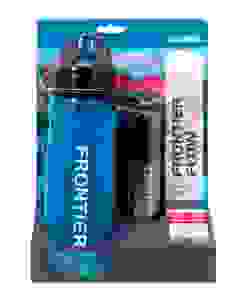
This is a recent upgrade to a previous Aquamira bottle; the new ones adds viral protection (in addition to chemical and bacterial and other microorganisms), making it seriously effective anywhere in the world.
Because it’s a recent modification to the Aquamira lineup, you’ll need to make sure it specifies viral protection (if that’s what you need, of course), and the replacement filters will be labelled Red Line. The bottle has other replacement filters, such as Green Line, but that’s for non-viral filtration (good for hiking in North America, and significantly cheaper, so it’s useful that you can swap them out as needed).
The numbers listed here are for the Red Line filter, to provide a direct cost comparison with the other top-of-the-line filters listed here, and the numbers are pretty great. It removes chemicals, 99.9999% of bacteria, and 99.999% of viruses and other microorganisms, with a 450 liter lifespan. The squishy straw is the type of thing that might need to be cleaned out every once in a while, but that’s true of most bottles anyway.
Full disclosure: The manufacturer has provided me with a few test products (though not this particular item), but all these numbers are accurate.
- Unit price: $50
- Replacement parts: $40 per cartridge (Red Line filter)
- Lifespan: 450 liters
- Initial water treatment cost: $0.11 per liter
- Recurring water treatment cost (cartridges): $0.08 per liter
- Empty weight: 5.6 ounces (158 grams)
Get it here.
They also make an in-line filter for attaching to a hydration bladder hose, which offers the same virus-removing performance, and is (at the moment) the only one I know of that does that.
4) Water to Go Bottle: $40 (approximately)
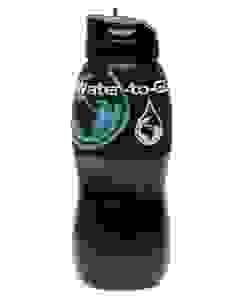
This is another one that might require overseas shipping, depending on where you live, but even with British pound conversion and international shipping costs, it’s still rather affordable.
The Water to Go Bottle removes 99.9% of biological contaminants (including viruses) and certain harmful chemicals, using a NASA-developed technology that removes particles from the water without using a “real” filter, but through a process called adsorption, though it also includes a carbon component for soaking up chemicals.
(The site claims it removes 99.9% of all microbiological contaminants, but elsewhere on the site they’ve listed the test results, which put both virus and bacterial removal at 99.9999%, and other types at 99.99%. I’m not sure what the 99.9% refers to.)
There’s a smaller bottle available as well, but the numbers here are for the one in the photo. Prices on their site are listed in British pounds, and the numbers here assume a conversion rate of 1 British pound equal to 1.5 American dollars, and don’t take into consideration the international shipping costs:
- Unit price: $37.50
- Replacement parts: $13.5 per cartridge
- Lifespan: 200 liters
- Initial water treatment cost: $0.18 per liter
- Recurring water treatment cost (cartridges): $0.067 per liter
- Empty weight: 4.8 ounces (138 grams)
Get it here.
5) Katadyn MyBottle: $60
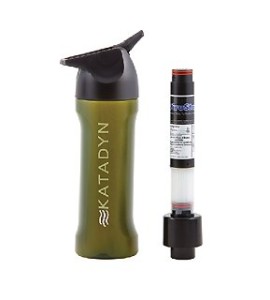
The Katadyn MyBottle uses a combination of filtration and iodine purification, to remove particles, and kill whatever microorganisms are inside. This is highly effective, but means the water will taste like iodine. This used to be the standard method for hikers everywhere, but some of the newer models, such as those listed above, manage the same level of safety without any added chemicals, which is likely to be a preferable solution for most people.
But it works, so I’m including it here, as it came in quite handy for me on trips through Eastern Europe and South America, and it’s quite simple. Besides, I don’t think it tasted so bad. I think it has been bested by some of the newer models out there, both in terms of non-iodine performance and cost-effectiveness, but it’s still quite functional, particularly if you use it only occasionally, in which case its moderately-cost-effective performance won’t add up too much.
- Unit price: $60
- Replacement parts: $35 per cartridge
- Lifespan: 150 liters
- Initial water treatment cost: $0.40 per liter
- Recurring water treatment cost (cartridges): $0.23 per liter
- Empty weight: 10 ounces (283 grams)
Buy it here.
If you DON’T need total purification
So this probably sounds horrifying, but there are a couple systems worth mentioning that only provide partial filtration, specifically focusing on removing biological contamination, which is the type of thing that works perfectly fine for hikers, but is not necessarily ideal for travelers, who will run into metallic tap water and maybe a virus or two. But if you’re hiking in North America, these might work for you:
7) SteriPEN Water Purifier systems: $100 (depending on the model)
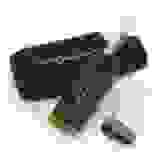
Although I much prefer all-in-one systems contained within the bottle, this is a popular device for backpackers all over the world, so I thought I’d discuss it here.
The important thing to remember is that the SteriPEN kills the microorganisms in the water with UV light, but does not actually remove them; it’ll be safe, but you’ll drink them right up. This also means it won’t remove chemicals, metals, particles, or anything else.
It’s possible to combine this with extremely cheap carbon filter bottles, which only remove large particles and certain chemicals, and thus combining them together would provide a more complete system. The Camelbak Groove and Brita water bottles come to mind.
You also need to use clear water, because the UV light will get blocked by sediment. You really don’t want to use this on muddy water, ever. You don’t want to use any filter with muddy water, but the other filters will actually clean it, which will damage the lifespan of the filter, but drinking muddy water with a SteriPEN might damage the lifespan of you.
The SteriPEN claims battery life long enough to clean 100 liters with 4 AA lithium batteries (about $2 each), which could be even cheaper with rechargeables (seriously, why does no one use rechargeable batteries?). The manufacturer will replace the bulb for $60, so the combined cost is still fairly cost-effective over long periods, but again, you’d need a separate filter if you wanted to remove metals, chemicals, and other stuff.
- Unit price: $100
- Replacement parts: $60 bulb, batteries of varying cost
- Lifespan: Approximately 8,000 liters (bulb lifespan)
- Initial water treatment cost (SteriPEN + 4 AA lithium batteries): $1.08 per liter
- Recurring water treatment cost (batteries + bulbs): $0.10 per liter
- Weight: 4 to 8 ounces with batteries, depending on the model (115 to 230 grams)
Buy it here.
8) The Sawyer Filter Bottle: $50
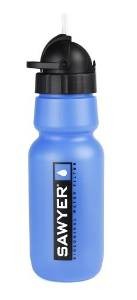
I have pointed out on many occasions that if you are only hiking in North America (and other places where viruses aren’t a problem), this is probably the best option out there.
The Sawyer bottle has a 0.1 micron filter size, which is good for everything biological except viruses, and it won’t handle chemicals, either, so it’s no good for low-quality tap water; but it’ll handle 99.99999% of bacteria, along with other bacterially-sized microorganisms (cysts, protozoa, etc), which works just fine for filling up from a river in the mountains, and is guaranteed to last for 3.7 million liters (minor note: these claims have been put to the test, and have been shown to come up short; it’s probably best to replace the filter long before the lifespan guarantee runs out).
There’s the arguable advantage of having something all-in-one, which can handle hiking and international travel and icky tap water, and some people might prefer that sort of minimalism; but if all you need is something for outdoorsy North American recreation, this is a good one.
- Unit price: $50 (though frequently found on sale)
- Replacement parts: None; buy the whole thing again
- Lifespan: 3.7 million liters (as mentioned, this claim is not sufficiently backed with evidence; it’s probably best to use it for a few months, just like the others)
- Initial water treatment cost: $0.000013/liter
- Recurring water treatment cost: $0.000013 per liter (as mentioned, it won’t last as long as they say, so this number should really be much higher)
- Weight: 5.5 ounces (155 grams)
Get it here.
There’s an in-line filter as well, for attaching to a hydration bladder, which offers the same performance.
Final thoughts
As you may have noticed, I’m a big fan of all-in-one designs. With the exception of specialized devices like the Sawyer Bottle and SteriPEN, all the options on this list can handle chemicals, bacteria and bacterially-sized things, and even those pesky little viruses (though with varying removal rates), though I would recommend using the ones with the highest removal rates if you’re going somewhere seriously questionable. Other pros and cons include some with great long-term cost-effectiveness, while others might offer swappable filters for low-grade filtration in less risky areas, and others might just fit better in your cup holder. A lot of this comes down to personal preference and ease of use, but performance is worth taking into consideration as well. But for reasons related to performance and ease of use, I’m sticking with the Grayl for now.

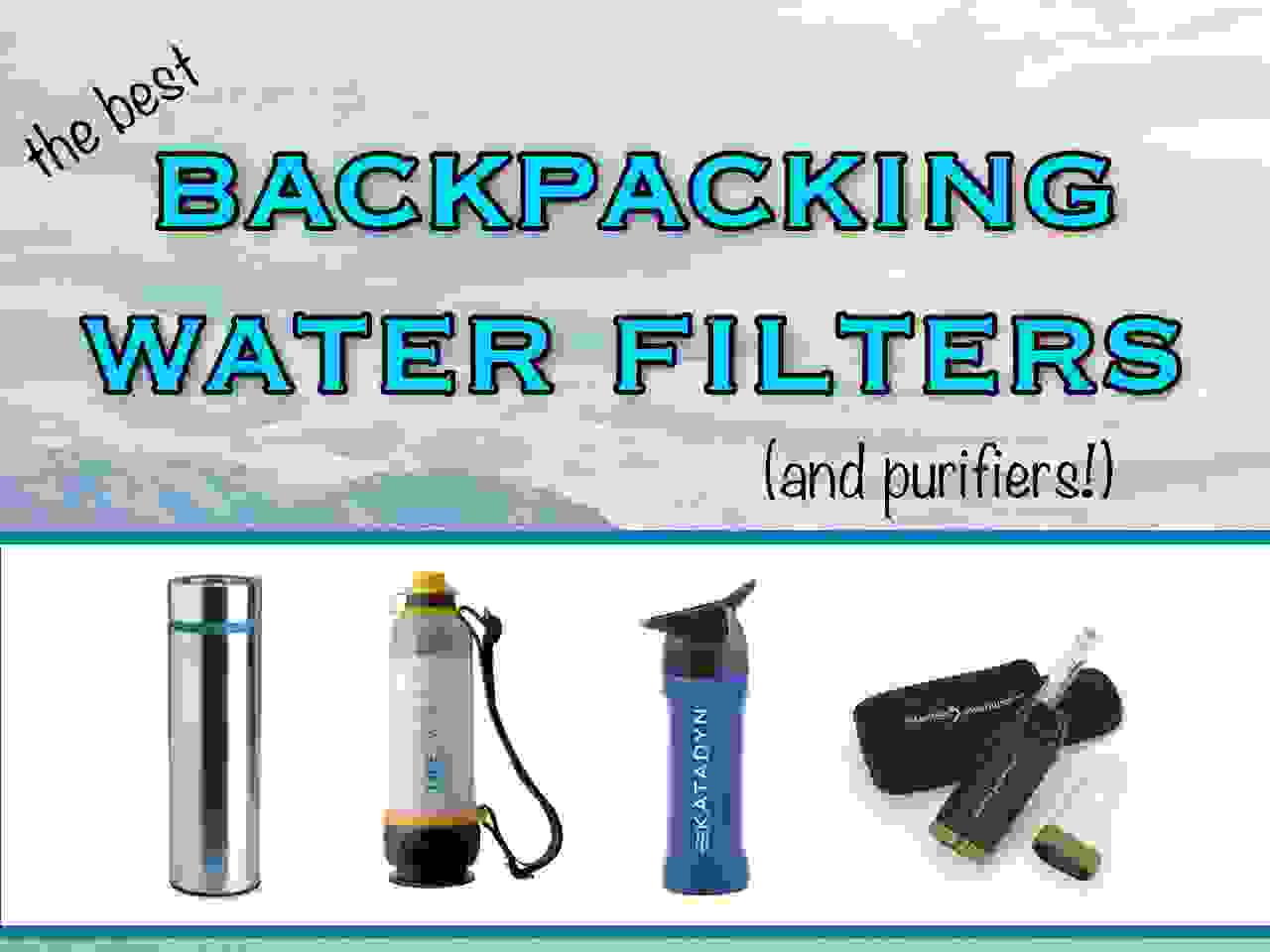



As someone who takes road trips for a week at a time and gets tired of buying bottled water in plastic, I found this VERY helpful! Thank you!! This saved me a lot of research!
No problem. I’ve spent the last…I don’t know, maybe 10 years following these sorts of things, and I’m always happy to help share what works.
I toured South America with a Water2Go bottle. It performed well, but the flow rate is a little slower than I’d like. It’s also worth noting that you can’t get 750ml in the 750ml as you have to take into account the size of the filter.
Eventually I dropped mine from the top bunk of a bed in Wild Rover, La Paz, and it broke.
Can’t faulty the watertogo bottle. Kept me safe for 9 months when backpacking in Asia (even from Indian tap water without getting sick). Re. the virus – the website says 99.999 for virus and 99.9999 for bacteria. https://www.watertogo.eu/additional-testing/
Certainly did the job for me! A friend on mine had the Lifesaver bottle which worked really well too – great for getting water to cook with. Only problem was it’s so big!
I’m seeing that now and you’re right. I was going off the “99.9% of all microbiological contaminants” claim they list on the individual product pages, but it looks like the specific categories don’t all have that same number.
Great Stuff!
A debt of gratitude is in order for this post. I’m getting into ultralight exploring however despite everything I believe I’m going for the Lifesaver. Appears to be too great to leave behind.
I’m travelling to Nepal for 3 months. What would you recommend? The LifeSaver or the Grayl? I’m not back packing much but I want to make sure I have clean drinking water.
The Lifesaver doesn’t quite exist anymore, so you should probably go with one of the other ones. You can probably still find the Lifesaver somewhere, but you might also have trouble finding any replacement parts, which means it’ll be an expensive purchase you won’t be able to make last long.
I know you have had rather snarky comments about it in the past, but the new LifeStraw bottle with carbon filtration is probably the best option for hikers, backpackers and trail runners in North America since it has both bacteria / protozoa protection and carbon filtration unlike your pet Lifesaver.
Yeah, I think the LIfestraw Go is a pretty good option, cost effective, easy to use, and so on. I have no problem recommending that one for domestic hiking and things like that.
Oops! I meant sawyer not Lifesaver.
I’ve been using the Steripens since they first came out and I find it the best all-around for international travel and general hiking – i’ve used it for years living in india, kenya, and traveling in east asia in all of cities/towns and rural areas, as well as backpacking in the western US. It’s super easy to use, fast, and so small and light. I like not having to carry around a specific bottle – i’ll sometimes want to buy some disposable bottles and use them if I need to suddenly carry multiple liters around, or I’ve UVed many rounds in a bottle to fill bladders/other containers. It’s fantastic for multiple people (easy to line up 4 nalgenes and treat them all in 6 minutes). It is important to get pretty clear water (ie if you can see color, it’s too turbid) – but for usual town/city water or springs, many streams, or most wells, that’s not an issue. if there’s any larger particles, I filter first with a handkerchief or any cloth I have around to get out any larger particles and then UV, or I can allow the water to settle and then decant it into another container before UVing.
I also keep a some chlorine or iodine tablets in my first aid kit as backup.
UV doesn’t, as you said, get rid of chemicals or metals, but that’s generally not a huge health concern for short term consumption (a few days or weeks) or for most places where you have municipal water or spring water. I’d only worry for long-term consumption (months-years) and/or in a place with a specific issue and without treated municipal water supply (ie arsenic from boreholes in bangladesh, water sources near mining/pharmaceutical protection/harmful industries, lead from municipal water in flint michigan etc.)
Are you certain the Aquamira Frontier handles chemicals and dissolved solids (heavy metals)? I wasn’t able to find any reference to that on Amazon, nor on their website (http://www.aquamira.com/product/frontier-flow-filtered-water-bottle-red-line/). It explicitly mentions virus/bacteria/cyst, then “taste & odor removal” does the latter definitively mean it removes chemicals & heavy metals too….? Or did you have another resource to get that information?
Click the button that says “technology” on that product listing page and they mention they remove chemicals. I’d like to see specific numbers on that, but they do have a carbon filtration stage, and that’s usually the easiest filtration step, so I’m not too worried about that.
Ah, gotcha! Thanks :)
What do you think about the “Survivor Filter?”
https://www.amazon.com/Survivor-Filter-Filtration-Replaceable-Pre-Filters/dp/B00LA97I8M/ref=sr_1_3?ie=UTF8&qid=1474615950&sr=8-3&keywords=survivor+filter
They claim it reduces heavy metals (carbon filter), does handle viruses, & 0.05 microns. Lasts 1000liters before requiring a filter change. I know you’re not a big fan of the “lifestraw” (bottle-less) form factor, but aside from that, it weighs 1/3rd the Greyl, the filter lasts over 6x as long, and it (supposedly) handles “everything” – meaning it could work for 3rd world tapwater, Africa, etc.
The Greyl does sound really nice to me, I just hate that you need a new filter every 40gal. That makes it really problematic for any kind of open-ended trip…
Hmm…0.05 microns is definitely pretty good, but some of the higher-end options go to 0.01, so I think this would catch most viruses, but not the tiniest ones. That’s not automatically a deal breaker, but that’s probably why it has a longer lifespan than some of the alternatives out there. I expect it’s better than plenty of options, but maybe not the absolute best of what’s available. Still, some of this is about increasing safety, not achieving perfection. But if you’re drinking out of a muddy river…I’d go for the best option.
>>I’d go for the best option.
I agree…the problem is, the more I research about this, the more I feel like I just can’t tell which is *really* the best. If the filtration is based on a membrane you can directly compare the “micron” values, but otherwise – i.e. in the case of the Grayl and others – you’re just trusting their numbers (99.9999 vs 99.99, etc). And every time I e-mail a company they make the identical claim that their filtration is by far and away the best in the industry (honestly, I’ve been told that by virtually *everyone* – same exact reply). For instance, I challenged Aquamira on the fact that their Red Line filter is only 99.99 vs viruses & 99.95 vs protozoa, vs others, like Grayl, are 99.9999 vs viruses & 99.999 vs protozoa. Their response:
“Aquamira Red Line filters are the only filters in the industry that are “certified” to that level. Since viruses and protozoa do not reproduce in water they really do not reach the high numbers in water that bacteria do. Therefore, those claims are just superficial and not relevant to the water industry. Since they are not certified at those levels, their claims are bogus. You can easily look at the EPA standards to see the desired levels of removal to understand the reasoning behind our claims. Since they can not justify or prove their claims through certification they are just a guess.”
So I feel like the more I research, the less I know about which is actually the best option… :P
I think at some point, it’s not quite worth worrying about anymore, and for me, that limit is three spaces after the decimal point. It’ll filter out plenty, and that’s pretty great. I do wish there were some sort of standardized test that every single thing on the market called a water filter had to go through, like the SAT or something. But oh well.
Yeah, I suppose you’re right. Anyway, thanks so much again for sharing all your research – it was a great starting point!
For what it’s worth, the two finalists I narrowed it down to were the Seychelle Advanced and Grayl. It was almost a tossup, but I ended up going with Grayl. The only thing I really don’t like about it is that the filter has SUCH a shorter lifespan (liters) than virtually everything else I found – half to a quarter – meaning that it’s impractical for very long trips (i.e. 1yr), and that the cost per liter is nearly 4x as much as other electroadsorption alternatives. But the ability to filter and then pour water for cooking, & the security of a really solid screw-top bottle that you know won’t leak in your bag, I figured was worth it. We’ll see how it goes… :)
The Grayl rocks. I have the Legend. The metal is awesome but you can’t get it to bent or you will not be able to press it down. This has not been an issue yet for me over 2 years of use backwoods camping. The new plastic/rubber looks interesting but I like drinking from ss.
btw I have no vested interest, never got anything from the company. I just really like this product.
Me too. I think they made the stainless steel thick enough that it’s hard to dent. It seems thicker than a Klean Kanteen, for example. But I’m scrawny, so I like the lightweight option.
Hi Justin,
Actually NSF/ANSI set standards than govern protocols for ratings and testing of water. 42 and 53 are related to (aesthetics) and (health effects) respectively. “According to NSF International and ANSI (two major safety certification organizations), the minimum standard for effective microbiological reduction is 99.9999 percent of bacteria, 99.9 percent of protozoan cysts, and 99.99 percent of viruses. This is based on a U.S. Environmental Protection Agency (EPA) report called the “Guide Standard and Protocol for Testing Microbiological Water Purifiers.”
Any purifier that meets or exceeds this standard, known as NSF/ANSI P231, can be said to effectively remove virtually all of these three contaminants present in water. Some purifiers actually exceed this NSF/ANSI standard, but as long as the rating is met for all three categories (bacteria, protozoa, and viruses), any difference in water purity beyond this standard can be considered negligible.”
Grayl has test results from an independent accredited lab that used NSF/ANSI water purifier test protocols. In short, Aquamira is full of crap. Grayl can “justify [and] prove their claims through certification” and any other company that makes claims should be able to provide you with test results. I trust Aquamira and the other companies sent you PDFs of their test results from independent labs?